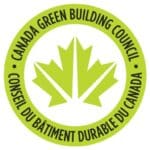Background
The CaGBC Zero Carbon Building (ZCB) Standard is a framework for designing and retrofitting buildings to achieve net-zero carbon in Canada. The standard takes a holistic approach on reducing carbon emissions in buildings including upfront (embodied) carbon emissions from building materials and construction and operational carbon emissions through reducing overall energy consumption, decreasing peak energy demand, and off-setting grid supplied power with on-site renewable energy generation.
The ZCB Standard is divided into two types: design and performance. The ZCB-design standard is applicable for new construction or major renovations, while the ZBC-performance standard is for annual certification of existing buildings. Certification for the ZCB-design standard is awarded based on the final design and how it reduces carbon emissions, such as achieving modeled operational carbon balance and reporting embodied carbon emissions through life-cycle analysis. Similarly, certification for the ZCB-performance standard is awarded based on one year of operating data, including achieving a zero carbon balance and offsetting embodied carbon emissions.

